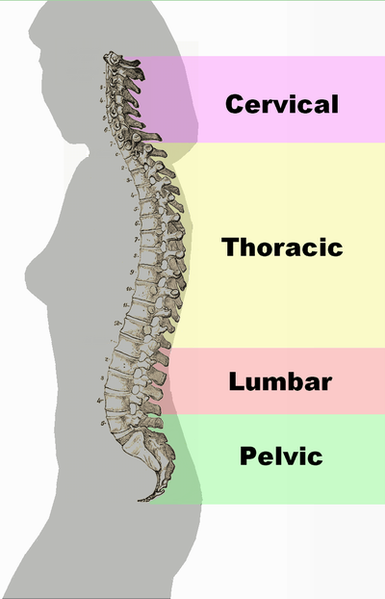This will sound odd but without reservation I can tell you that I’m all kinds of giddy over the thoracic spine (aka t-spine)! I’ve been reading quite a bit lately about the t-spine and learning about the implications of proper t-spine mobility and strength. Bret Contreras has a good article on the topic. Mark’s Daily Apple has two articles on the topic, this one and this one. This PDF from Mark Buckley is very informative. And Nick Tuminello discusses the do’s and don’ts of the spine in general in How Not to Warm Up. I’ve got a few drills to show you that should be done by any modern Westerner–that is, anyone who sits for a living, drives a car, watches TV and/or bicycles. But first, what is the t-spine?
Anatomy
Your spine or vertebral column normally consists of 33 bones. You have seven cervical vertebrae in the neck region, 12 thoracic vertebrae that make up the mid-back, and five lumbar vertebrae that make up the low back. Down at the very bottom you’ve got the sacrum and the coccyx, aka the tailbone. So think of your t-spine as starting from the base of your neck and ending on an even level with the top of your hip bones. So why should you care about this region?
The thoracic spine is built for movement. This part of our spine was made to twist, flex forward and sideways, extend back plus a combination of all the above. But look at the modern Western lifestyle: We sit and we hunch. We hunch at a computer. We hunch over a steering wheel. For fun, we hunch in front of a TV. If we’re cyclists, then we hunch even during our athletic event. If we play golf or softball then we get rotation but generally only in one direction. In other words, the t-spine spine gets very little movement. What are the implications?
Organ function
It’s fairly obvious that most of our internal organs rest near our t-spine. Those organs are innervated by nerves that exit out of the thoracic spine. This means those organs send and receive information to and from the brain by way of the t-spine. Have a look at the chart and notice which organs receive their nerve supply from the t-spine region.
If this part of your spine is immobile then you could have compromised organ function. That could mean anything from hand and wrist pain to breathing issues, thyroid issues, heart dysfunction, kidney dysfunction, digestive trouble, and who-knows-what-else. Thus mobilizing this area may well improve organ function.
Limb function & pain issues (or avoidance thereof)
Proper t-spine movement is tied very strongly to good shoulder and arm function and to good low-back health. (I’ve had personal experience with this, both with my own pain issues and with various clients.) A gunked up t-spine means the shoulders are going to move badly. A tight t-spine will likely result in shoulders that are unstable. Thus the shoulders may pay the cost of poor t-spine movement. Similarly with the low-back.
The lumbar spine is not a terribly mobile part of the body. It has about 6-7 degrees of rotation in each direction. The t-spine however has about 35 degrees of rotation each way. Your entire spine rotates as you walk, run, swim, reach behind you and obviously if you golf, swing a bat or throw a punch. If you lose t-spine rotation then your lumbar spine will likely start to compensate and rotate more than it was designed to. So that low-back pain you keep heating and icing and stretching, etc? It very likely may be caused by poor t-spine movement.
Appearance
Why do most of us work out? We may say “just to be healthy” or “my doctor told me to, but the real honest reason most of us exercise is for looks. There’s nothing bad about looking good! Good t-spine movement and positioning can help you look better instantly.
Remember that we’re a hunched over society. Look around you. How many rounded shoulders do you see? This doesn’t look great. Imagine if people drew themselves up, lifted their collarbone, and lengthened their spines. No question but that we’d look stronger, healthier and more attractive.
Okay, so there’s some info on what your t-spine is and why proper movement is vital. Now it’s time to move! (Please pardon the discrepancy between the audio and video. I’m trying to figure out what the problem is. Youtube is a challenge for some reason.)



Excellent! This was very clear and it all makes perfect sense. The great thing about these exercises is that you can do them right at your desk where so many of us are spending our sitting lives!
Nicely done. Finally something useful from a seated position. Keep up the great work. I learn something new everytime I visit your blog.
Great movements for a day when a blizzard is keeping me inside; actually great for every day. Also, easy and efficient with high payoff.